The Her Campus National Editors write about products we love and think you’ll love too. Her Campus has affiliate partnerships, so we get a share of the revenue from your purchase. All products are in stock and all prices are accurate as of publication.
In the age of two-day shipping, reward points, and endless email promotions, it’s easy to succumb to exuberance—especially with self-care products. Whether you have 50 skincare products crowding your shelves or less than five, this guide is here to help you prioritize your skin’s basic health and not much else—saving both your wallet and your shelf space.
1. Take a few minutes to figure out your skin’s personality.
Think about how your skin behaves. Is it dry? Is it oily? What parts flake and what parts seem fine? Do you have red, inflamed acne, or cysts that turn into pimples once a month? Over time, with fluctuations in hormones, diet, and general lifestyle changes, your skin may have gone through many changes. This is normal. Try to get a sense of how it’s doing now, generally, and over the past 6 months or so. Be sure to account for climate and general weather trends—dry, cold air makes skin behave differently than wet, warm air.
2. Take stock of your favorite products—and the ones that never worked for you.
Everyone has at least one Holy Grail (HG) product that they swear by, will never switch from, and will cry if it becomes discontinued. Make a list of your HGs along with the products that you’re not 100% in love with but still enjoy using. Do you notice any trends in brands and ingredients? Keep note of that too, for your inevitable shopping list. You gotta restock eventually!
In addition to a list of the products you like, go ahead and make a list of the products you wouldn’t touch with a ten-foot pole—like the moisturizer that clumped up over your serums and the retinoid serum that broke you out.
3. Wait… retinoid serum?
Unless you have clinically-treated acne or you’re obsessed with skincare, you may not know what this is. Retinoids are prescribed by dermatologists to treat acne. Retinol serums, meanwhile, are a weaker form of retinoids that you can buy over the counter. These chemical agents promote cell-turnover and collagen production in your skin. Collagen is the thing that makes your skin elastic and prevents wrinkles and sagging. Cell-turnover simply pushes the dead skin cells up to the surface and helps your skin shed them away. If you’ve ever tried retinol and broken out, there’s a chance that’s why; the increased cell turnover can cause a mini purge in your skin because it triggers an emergence of congested, excess sebum to the surface of the skin.
To learn more about the specific benefits and uses of retinol, check out this article by fellow Her Campus writer Sammi Burke. Retinol is the only superfluous product I will recommend keeping in, or adding to, your routine.
4. Okay, what other products should I have in my routine?
I’m so glad you asked. This is my recommended list. It’s short (comparatively), it’s sweet (don’t taste anything though), and it’s simple (your mileage may vary).
Sunscreen (yes, everyone should be using it—more on this later)
Cleanser (add a cleansing balm to this if you wear daily makeup and/or waterproof sunscreen)
Exfoliator (chemical, not physical—more on this later)
1 treatment serum for a specific issue you have (optional, but encouraged)
Moisturizer
Occlusive (as part of your night-time routine)
5. Occlusive? I don’t know what that is, but just the name sounds like it’s going to break me out…
There’s no need to fear: occlusives aren’t going to break you out, not unless you use them incorrectly. Occlusive ointments protect the skin by trapping water against the surface of your face, which assistsyour moisturizer in pulling the water underneath the skin barrier for proper hydration. This is because good moisturizers are chock full of hydrating agents such as honey or glycerin. The occlusive, meanwhile, may have oil or petrolatum, and it will heal your skin by bolstering that hydration process.
If you have inflamed pimples, dry patches, or your skin burns when you wash it, it may be time to use an occlusive. Simply put it on as your last step following your moisturizer at night and make sure to prioritize those aforementioned problem areas. If you have very oily skin, this may be worth a try too. There’s a chance your skin is overproducing oil because the skin barrier is damaged, and your skin is significantly dehydrated. When damaged, the barrier is unable to contain enough moisture to protect your skin. The excess oil is your skin trying to make up for a lack of moisture balance.
I guarantee you, once you see how well occlusives work for you, you will never go without them. Estheticians like @caveofbeauty and @MakeupForWOC on Twitter swear by the power of occlusives like the Cerave Healing Ointment. I’ve been converted, and so will you.
6. Let’s talk exfoliators.
The most common mistake of people using exfoliators is to use something with a physical exfoliator in it. Harsh scrubs create micro-abrasions and tears in your skin, which invites bacteria and inflammation. No thank you. Please stop using them on your face. If you own any already, start using them as a body scrub instead. Your body skin can generally benefit from a scrub—your face, not at all.
The second most common mistake of people using exfoliators is to buy an incredibly strong agent, like that one, super popular, TikTok famous red mask everyone was using… don’t do that. Lactic acid, glycolic acid, and even milder salicylic acid washes are better than that mask. If you use it and it works for you, I’m happy for you! Just be wary of over-doing it and damaging your skin barrier.
The thing is, most people don’t need to exfoliate more than once or twice a week, if at all. The thing to remember about exfoliation is that it’s simply clearing the way for your serums to penetrate your skin while also bringing to the surface any blemishes and sebum congesting your skin below the surface. After a purging period, you’ll find that semi-regular exfoliator use might make your breakouts less common—and you don’t need to use super strong exfoliators to see that happen.
The third most common mistake of people using exfoliators is to use them on active acne cases. The places where acne has breached your skin needs hydration and healing above all else—exfoliators should generally stay far away. In this case, I recommend you get the specific advice of an esthetician, or talk to a dermatologist about a prescription for something stronger (tretinoin, Accutane, or antibiotics). And use a moisturizer, an occlusive at night, and of course: SUNSCREEN!
7. Sunscreen? As. If.
Please please please please please please PLEASE use sunscreen, for the love of all that is holy, please use sunscreen. 30 SPF or HIGHER. It saves you so much pain down the line. The sun exacerbates all of your pre-existing skincare issues. Acne? Yup. Dryness? Yup. Hyperpigmentation? YUP. The sun also affects all skin tones just as badly, regardless of how melanated your skin may be.
Not to mention, it causes more skincare issues down the line, from benign wrinkles to skin cancer. I’m not trying to be a fear-monger. I just want everyone to know all of the facts. I also want to address some common complaints about sunscreen.
If you find sunscreens to be greasy and gross-feeling: find a mattifying sunscreen—mineral creams do this well.
If you find that your sunscreen doesn’t blend smoothly and imperceptibly into your skin: use a lighter, chemical sunscreen–one with a reef-safe formula and without avobenzone, which can cause eye irritation.
If you find that sunscreen just smells weird: find one that is scented or has no scent.
If you find that sunscreen is too expensive… You got me there. Unfortunately, sunscreen is one of capitalism’s biggest modern scams.
Companies created a whole industry around the problems the sun gives you, and they make one of the only preventative measures really expensive and manufacture it in super tiny bottles. And of course, the sun is unavoidable. And of course, you have to use a lot of sunscreen (three fingers’ worth for your face AND neck—NEVER forget the neck!!). And of course, you have to use that much sunscreen multiple times a day (you must reapply it!!). But I promise you, high quality, nice-feeling, blend-able, non-smelly, affordable sunscreen is out there!
8. This list was supposed to help me simplify… but it’s just really long and full of conditions. Also the hunt for a good sunscreen sounds so difficult. What gives?
I hear you. The skincare journey can be a long and arduous one, especially when you first start out. This is because it’s really, really difficult to give universal advice on anything relating to personal health, especially skincare. By the way, you shouldn’t trust anyone who is claiming that one thing or another is a one-size-fits-all, unconditional solution to everything. (Except Cerave Healing Ointment. That is heaven-sent.)
Your best bet is to do your own research, fact checking along the way, and find online estheticians who discuss your specific skincare issues and see what they have to say on their public pages. I recommend Nai, otherwise known as @LaBeautyologist on Twitter and The Golden RX on Youtube for an introduction to a variety of skincare topics. Nefertiti, otherwise known as @nefertitis.face on Instagram, offers a wide assortment of reels and posts giving detailed product reviews and recommendations. I discovered many of my favorite products thanks to Nefertiti. The aforementioned @caveofbeauty and @MakeupForWOC (both on Twitter) are both really wonderful resources for learning more about how to take care of your skin.
An appointment with any sort of esthetician or dermatologist may not be in everyone’s budget, so sometimes the best thing you can do is see what advice they’re putting online for free. But I’ll tell you right now, nearly all of this article’s advice came from my own skincare journey, which I started from scratch online. The rest came from trial and error with trying out new products.
9. Okay, okay… what do you use?
Nobody is really asking this… but if you are… I must share:
Sunscreen: Paula’s Choice Extra Care Non-Greasy Sunscreen SPF 50
Cleanser: Youth to the People Superfood Cleanser
Exfoliator: KraveBeauty Kale-Lalu-yAHA Exfoliator
1 Treatment Serum for a specific issue you have: myTopicals Faded Serum
Moisturizer: FirstAidBeauty Ultra Repair Cream
Occlusive: the divine aforementioned Cerave Healing Ointment
This routine came through a lot of trial and error, and it’s subject to change depending on any new issues I want to fix. However, I feel like these products could genuinely work on any skin type. Almost all of these products were developed with sensitive skin and restoration in mind. Not to mention they include superfoods and antioxidants for extra environmental protection, as well as agents for hyperpigmentation treatment and prevention.
10. Now what?
Give away the stuff that doesn’t work for you. Look at the brands you have already and see if they have anything else that catches your eye and fits into the archetype list of recommended products. But before you cash out on anything, do enough research that you’re confident you’re gonna like what you try. No worries if not, though. Moisturize, recover, and remember: another perk of today’s age of easy come, easy go consumerism is that everyone’s return policies are amazing (still double check that fine print though).


